Learn how to cook delicata squash. This sweet and mellow flavored winter squash is a great side dish, and perfect for topping salads or mixing with grain dishes. Named for it’s thin and “delicate” skin, delicata cooks quickly and does not need to be peeled – making it an easy to prepare winter squash!
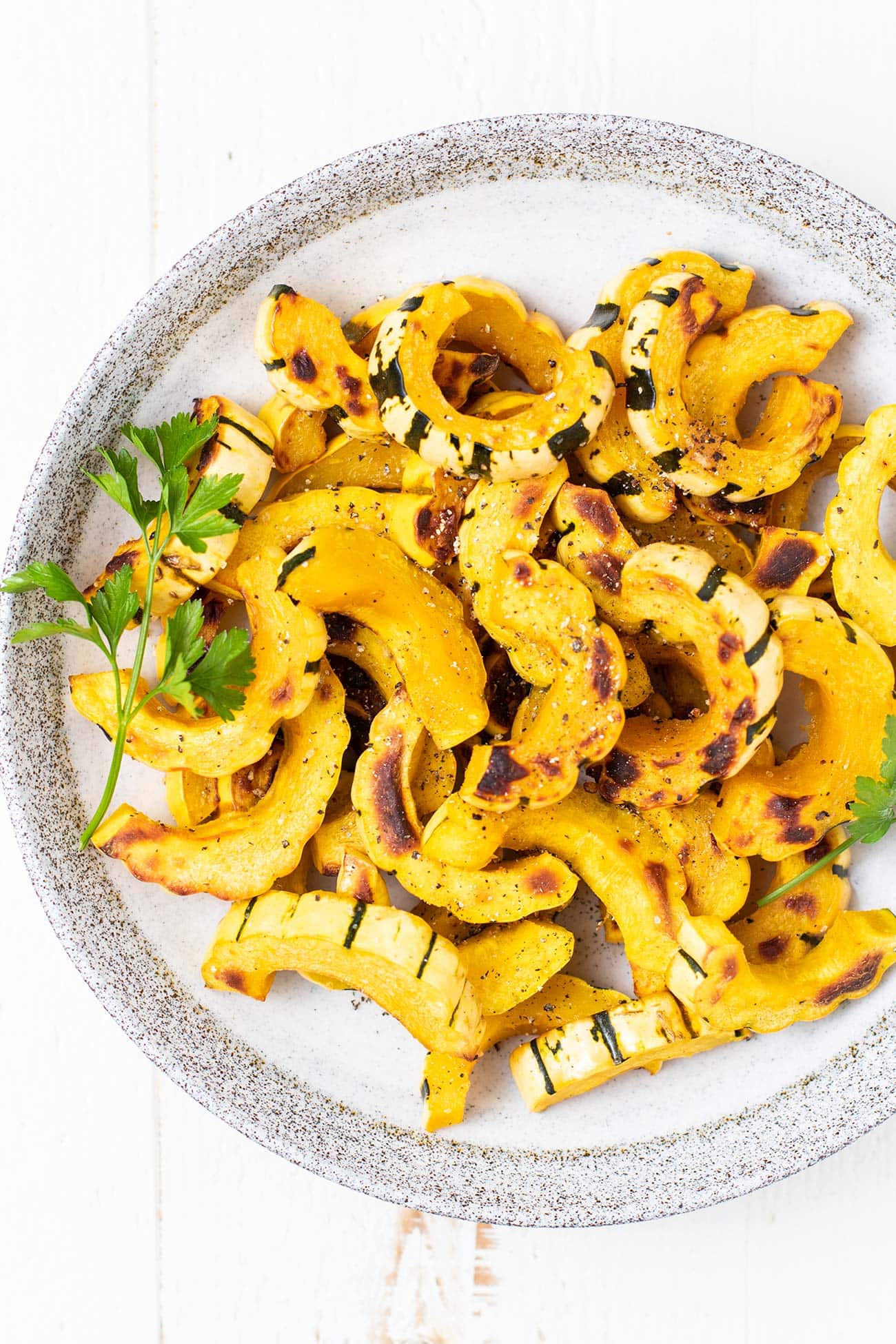
Contents
What is Delicata Squash
Delicata squash is a small, oblong squash that is pale or bright yellow, with green or orange stripes. It is also known as peanut squash, sweet potato squash, bohemian squash, and sweet dumpling squash [source].
They can be long and thin, or have a more rounded appearance. The skin is thin and delicate, giving this squash its name, and doesn’t need to be removed to cook or eat.
While having a lighter or darker golden color doesn’t seem to matter, the vibrancy of the green stripes does. Darker green lines mean a more mature (ripe) squash, and lighter green lines indicate an unripe squash.
This can be seen when the squash is cut open. Delicata with lighter green stripes will have small, under developed seeds, while squash with darker green lines will have larger, mature squash seeds.
If you don’t see delicata at your regular grocery stores, check speciality stores like Whole Foods or Natural Grocers. It’s also often found at Farmers markets. They start to arrive early fall and are available through early spring!
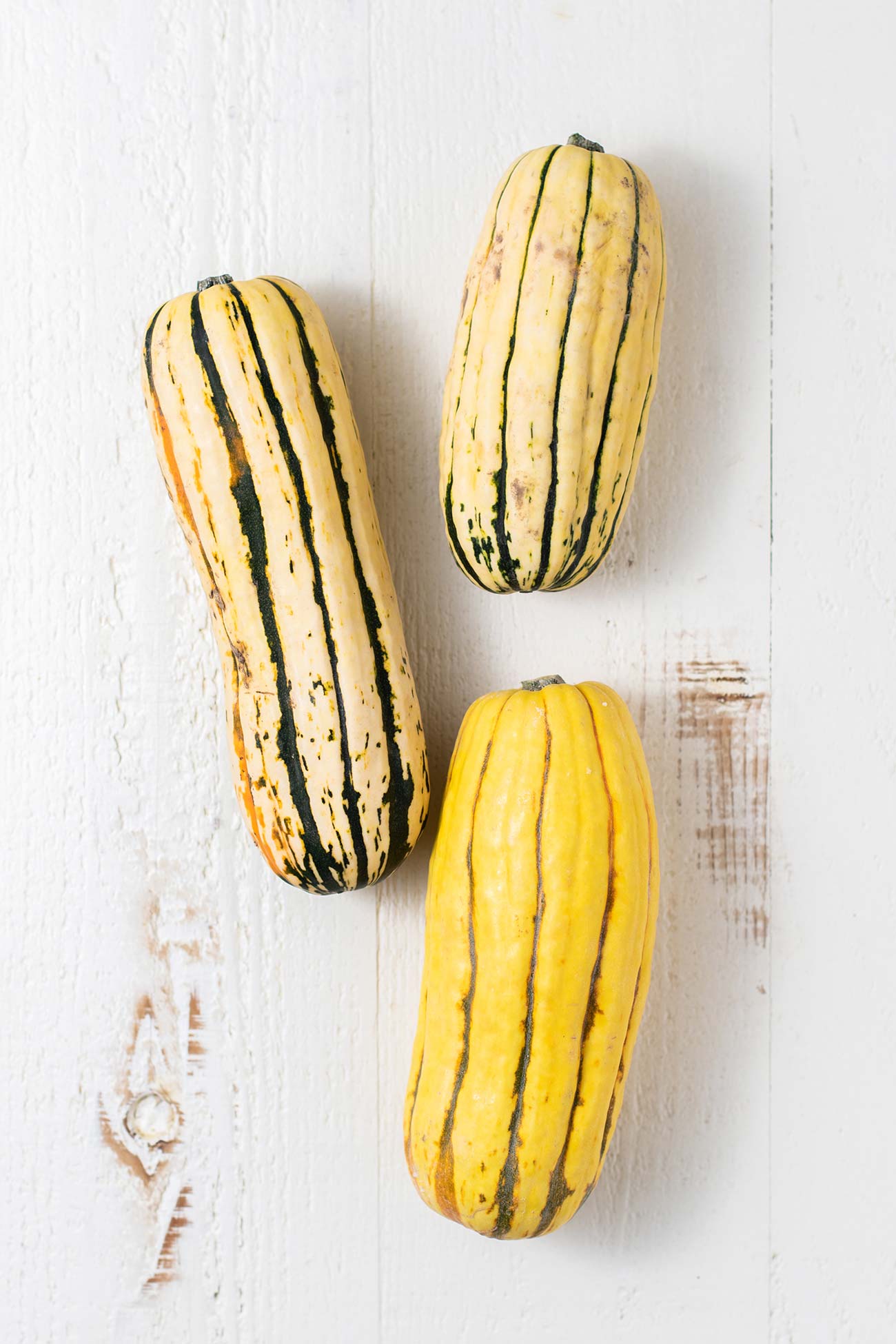
This recipe is the perfect method for Oven Baked Delicata Squash. If you need a stovetop recipe, try this Sauteed Delicata Squash recipe! Looking for ways to serve this? You’ll adore this Holiday Spinach Salad with Hot Bacon Dressing (featuring roasted delicata!).
Delicata Squash Nutrition
Delicata is one of my favorite winter squashes. It’s easy to cut and prep, and cooks quickly. Throwing hot slices adds a comforting, sweet, and creamy flavor to winter meals.
It’s mostly carbohydrate, with little fat or protein. A one cup serving has 9 grams of carbs and 4 grams of fiber [source].
It’s high in a wide range of vitamins and minerals, including vitamins A, C, and B6, iron, potassium, and manganese. One of the most unique nutritional boasts is its Omega 3 fatty acids, with 1 cup providing 12% of the recommended daily value [source].
Interested in other nutritious winter squash? Learn how to cook spaghetti squash and how to cook butternut squash.
What You’ll Need
- Delicata Squash
- Olive Oil or Avocado Oil
- Sea Salt and Black Pepper
- Optional: A sweetener, like honey, maple syrup, or brown sugar.
- Optional: Sage, thyme, or rosemary
- Optional: Parmesan Cheese (great sprinkled on to hot squash!)
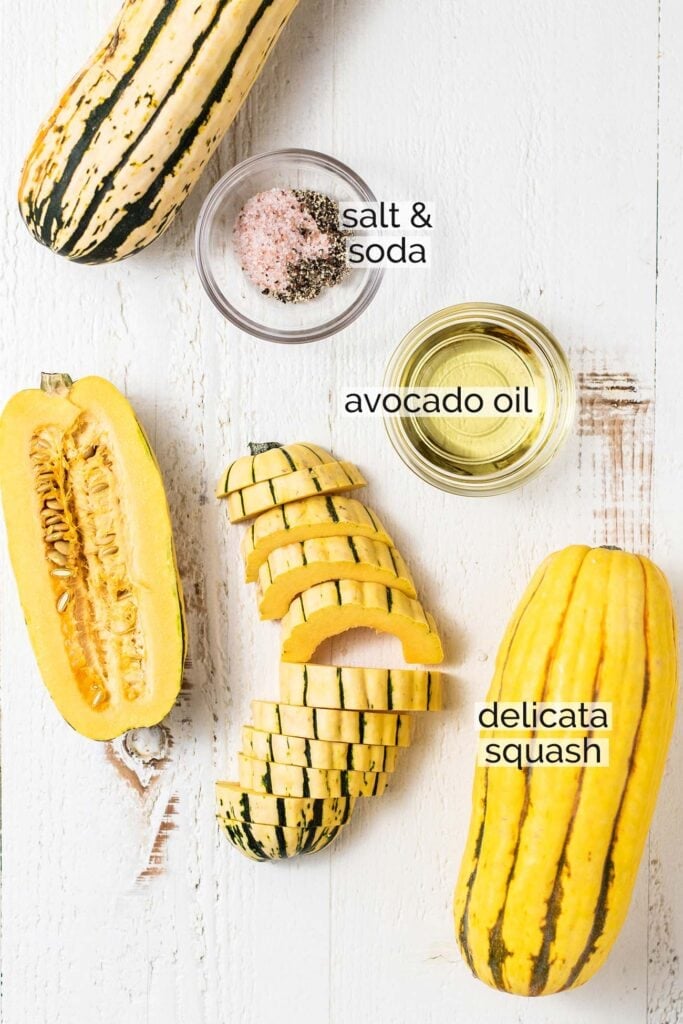
How to Make Roasted Delicata Squash
Step 1: Cut the delicata squash in half lengthwise with a sharp knife. The squash’s thin skin makes this easy. Use a spoon to scoop out the pith and the seeds.
Step 2: Slice the squash into half inch slices resembling half moons.
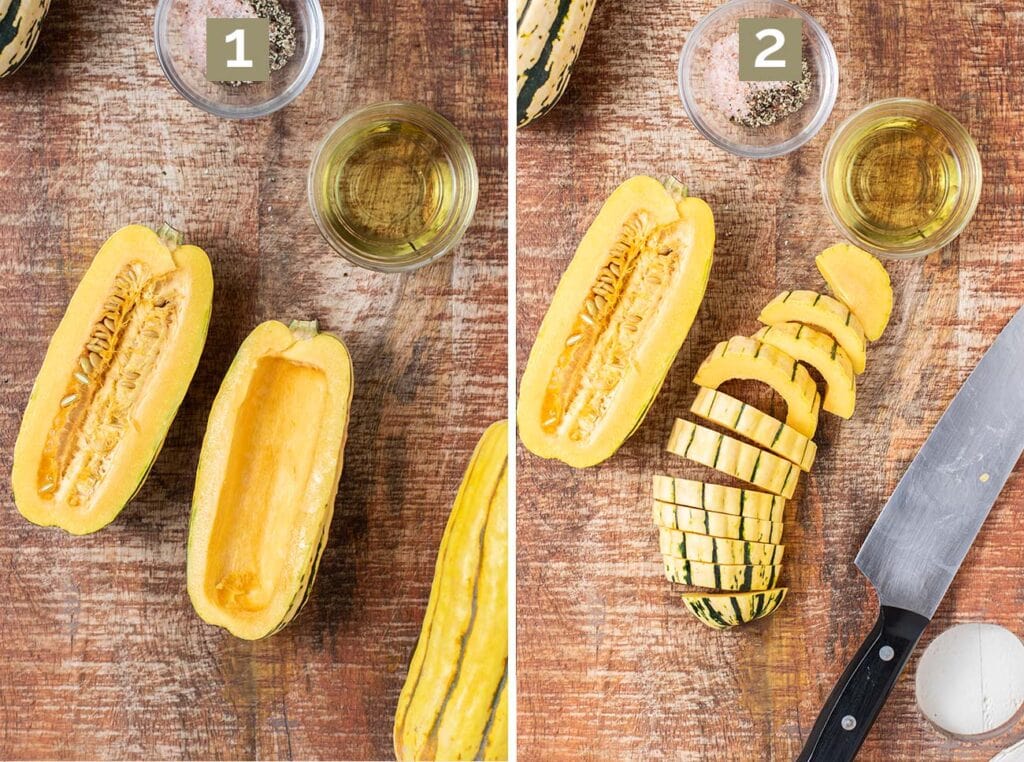
Step 3: Line a large sheet pan with parchment paper or a silicone liner, and lay the squash out in a single layer. Drizzle or spray the squash with avocado oil or olive oil. (If desired, add a drizzle of maple syrup or honey, or other seasonings.)
Step 4: Bake the squash in a 400º F preheated oven for 25-30 minutes. I peek in after the squash has been baking 20 minutes, and then take it out when the squash is lightly golden brown. Do not over-bake delicata squash because it’s delicate nature means it will dry out faster than other squashes.
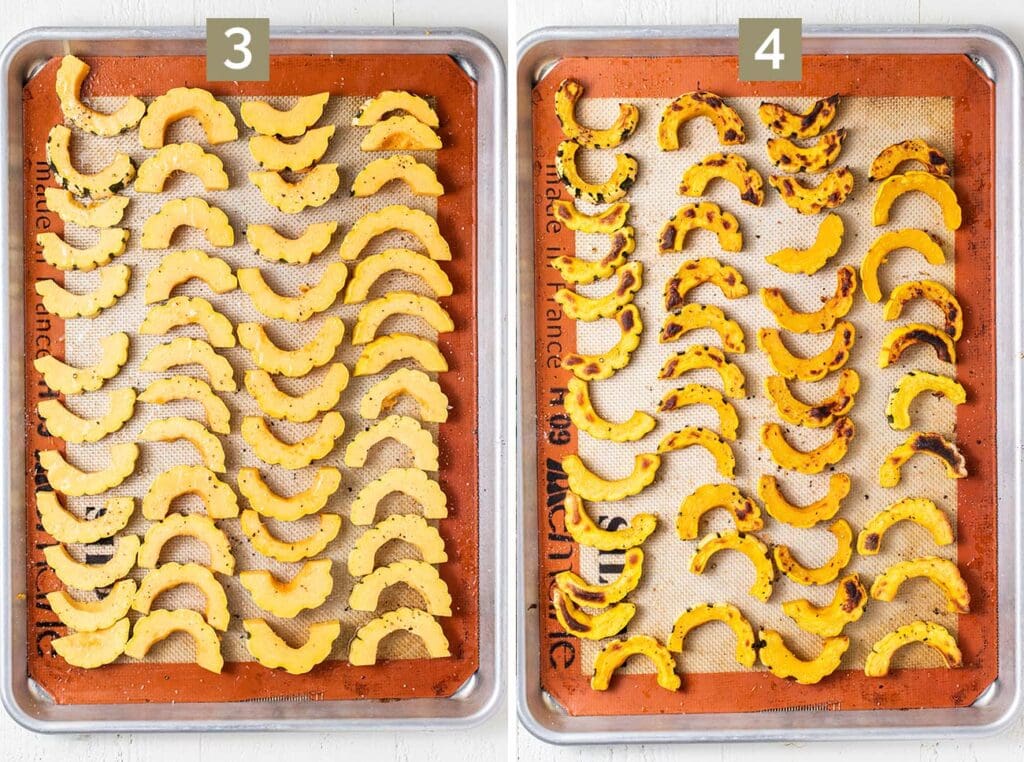
How to Store Leftover Squash & FAQ
Store leftover baked delicata squash in an airtight container in the refrigerator for up to 4 days.
To reheat the squash, add it to a skillet over medium heat and saute it until it’s hot throughout.
It’s also delicious added cold to salads. I love to saute leftover delicata with scrambled eggs for breakfast.
Also try this stovetop method for Sauteed Delicata Squash.
Do you Eat the Skin on Delicata Squash?
The skin on a delicata squash is thin, and when baked, becomes soft. Delicata squash is most often served with the skin.
It is not as tough as the skin on other winter squashes, like a spaghetti squash. This makes delicata squash an excelled source of both soluble and insoluble fiber, since the skin is eaten rather than discarded.
Is Delicata Squash similar to Butternut Squash?
Delicata squash has a creamy and sweet flavor similar to butternut squash. However, it is lighter in texture and has a more mild flavor.
It is a smaller squash and less dense than butternut, meaning it bakes faster and is suitable for sauteeing as well.
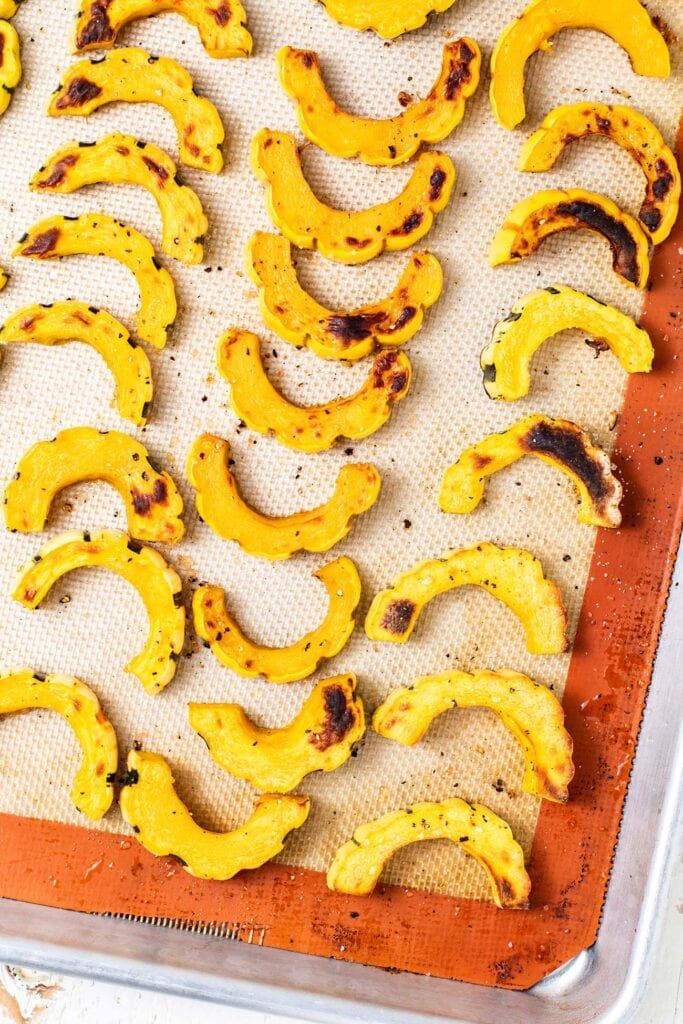
Delicata Squash Recipes
If you’re interested in trying delicata squash, but aren’t sure what to do with it, here are some ideas:
- As a side dish, seasoned simply with salt and pepper
- Added into salads. I like to add the hot squash to cold salads to make them more appealing in the winter.
- As a “base” to add sauces to. I like to use this squash as a replacement for rice or pasta. Layer on your favorite pasta sauce, toss in pesto, or even use under a curry.
- Delicata squash is lower in carbs, as far as winter squashes go, because of its higher fiber content. Use delicata squash similar baked sweet potatoes as a carb-based side dish that’s lighter.
Or, you can try one this very special recipe!
Other Thanksgiving Side Dish Recipes
- Brussels Sprouts with Pomegranate and Pecans
- The Perfect Baked Sweet Potatoes
- Gluten Free Green Bean Casserole
I’d love to connect with you on social media! Find me on Facebook or Instagram where I post daily healthy eating and lifestyle inspiration!
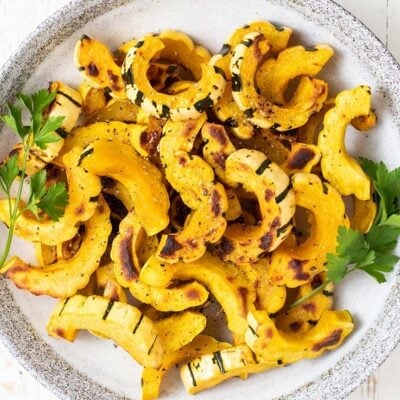
Delicata Squash
Ingredients
- 2 delicata squash
- 1 tablespoon avocado oil
- sea salt to taste
- black pepper to taste
Instructions
- Preheat the oven to 400ºF. Line a baking tray with parchment or a silicon baking liner and set aside.
- Cut the squash in half lengthwise. Use a spoon to scoop out the seeds and pith. Cut the squash in 1/2 inch slices resembling half moons.
- Lay the squash out across the baking tray in a single layer. Drizzle or spray with avocado oil, and season with salt and pepper to taste.
- Bake the squash for 25-30 minutes. Check the squash after about 22-25 minutes and pull it out if the squash has started to brown, and is soft and creamy. Continue baking up to 30 minutes if it doesn't look quite done.
Video
Notes
- As a side dish, seasoned simply with salt and pepper
- Added into salads. I like to add the hot squash to cold salads to make them more appealing in the winter.
- As a “base” to add sauces to. I like to use this squash as a replacement for rice or pasta. Layer on your favorite pasta sauce, toss in pesto, or even use under a curry.
This is such a pretty side dish!